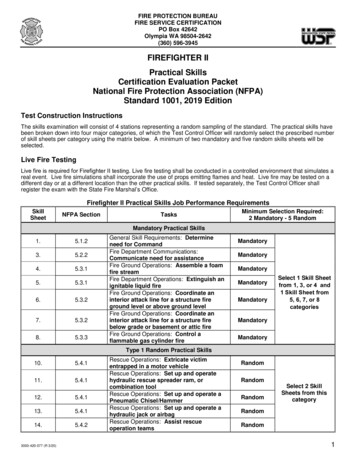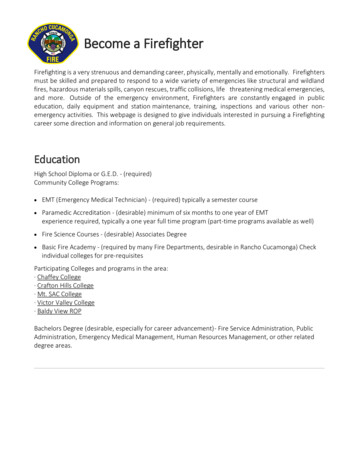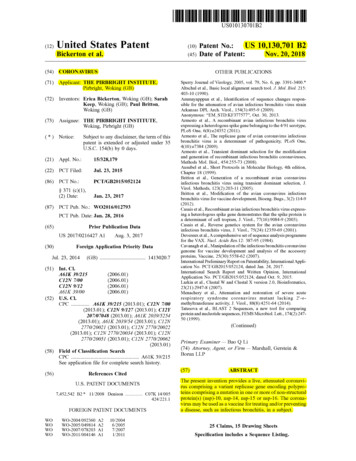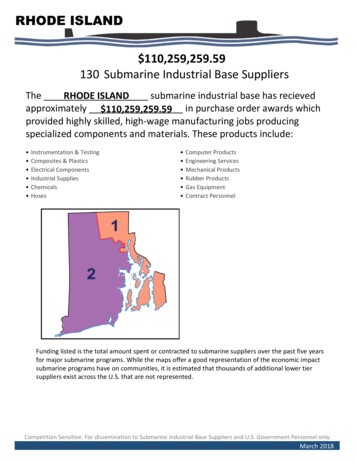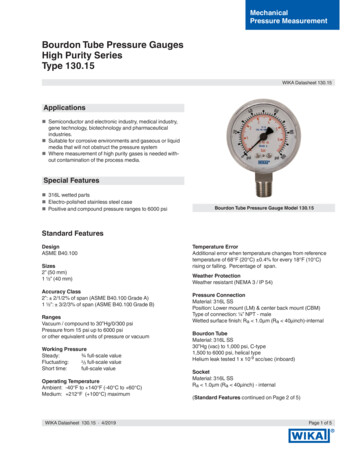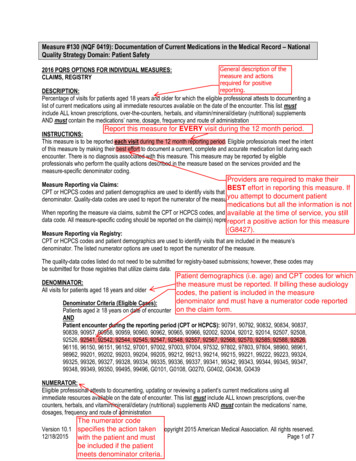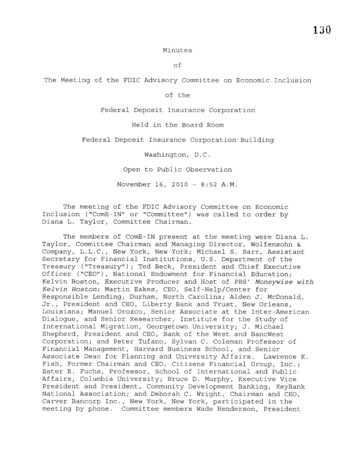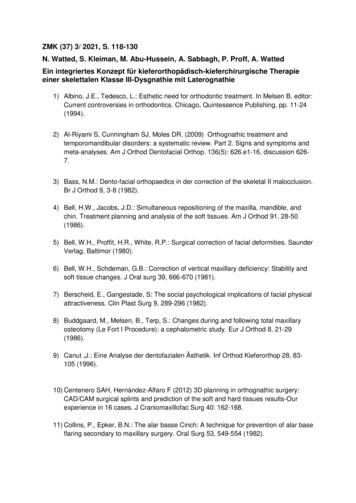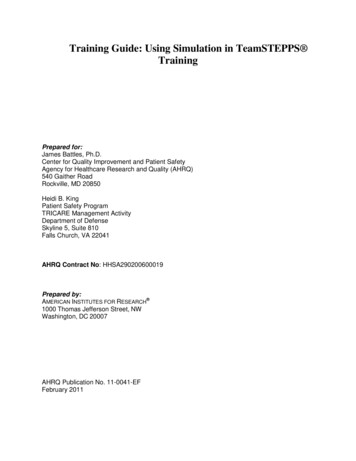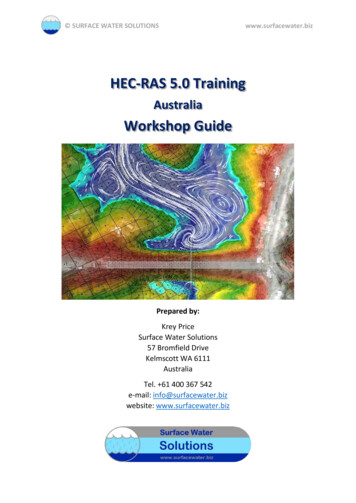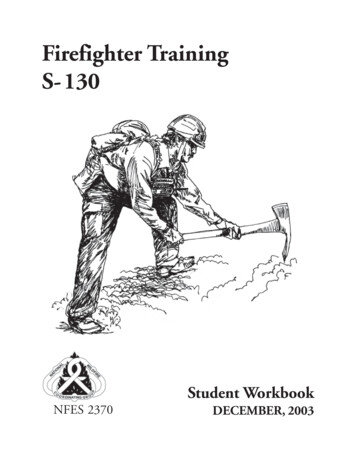
Transcription
Firefighter TrainingS- 130Student WorkbookNFES 2370DECEMBER, 2003
Description of the Performance Based SystemThe NWCG Wildland and Prescribed Fire Qualifications System is a “performance-based” qualifications system. In this system, the primary criterion for qualification is individual performance as observedby an evaluator using approved standards. This system differs from previous wildland fire qualificationssystems which have been “training based.” Training based systems use the completion of trainingcourses or a passing score on an examination as a primary criteria for qualification.A performance-based system has two advantages over a training based system: Qualification is based upon real performance, as measured on the job, versus perceivedperformance, as measured by an examination or classroom activities. Personnel who have learned skills from sources outside wildland fire suppression, suchas agency specific training programs or training and work in prescribed fire, structuralfire, law enforcement, search and rescue, etc., may not be required to complete specificcourses in order to qualify in a wildfire position.1.The components of the wildland fire qualifications system are as follows:a.Position Task Books (PTB) contain all critical tasks which are requiredto perform the job. PTBs have been designed in a format which willallow documentation of a trainee’s ability to perform each task.Successful completion of all tasks required of the position, asdetermined by an evaluator, will be the basis for recommendingcertification.IMPORTANT NOTE: Training requirements include completion of allrequired training courses prior to obtaining a PTB. Use of thesuggested training courses or job aids is recommended to prepare theemployee to perform in the position.2.b.Training courses and job aids provide the specific skills and knowledgerequired to perform tasks as prescribed in the PTB.c.Agency Certification is issued in the form of an incident qualificationcard certifying that the individual is qualified to perform in a specifiedposition.ResponsibilitiesThe local office is responsible for selecting trainees, proper use of task books,and certification of trainees, see appendix A of the NWCG Wildland andPrescribed Fire Qualification System Guide, PMS 310-1, for furtherinformation.
Firefighter TrainingS- 130Student WorkbookDECEMBER, 2003NFES 2730Sponsored for NWCG publication by the NWCG Training Working TeamComments regarding the content of this publication should be directed to:National Interagency Fire Center, National Fire Training Support Group, 3833 S. Development Ave., Boise, Idaho83705. Email: nwcg standards@nifc.blm.gov.Additional copies of this publication may be ordered from National Interagency Fire Center, ATTN: Great BasinCache Supply Office, 3833 South Development Avenue, Boise, Idaho 83705. Order NFES 2730.
PREFACEFirefighter Training, S-130, is required training for qualification as a Firefighter 2(FFT2) under the Wildland and Prescribed Fire Qualification System Guide, PMS310-1.The original Firefighter, S-130 course was developed in 1981 by an Interagencyteam and revised in 1994. The 2003 version updates that course and wasdeveloped by an interagency team composed of:Ben Jacobs - National Park ServiceCraig Cook - Bureau of Indian AffairsBobi Stiles - US Forest ServiceMichelle Ellis - US Forest ServiceTom Adams - State of OregonRich Mattingly - National Park ServiceShane Del Grosso - US Fish and Wildlife ServiceComments regarding this package or additional information should be addressed to:nwcg standards@nifc.blm.govNational Interagency Fire CenterFire TrainingTraining Standards Unit3833 South DevelopmentBoise, Idaho 83705i
ii
CONTENTSPREFACE . iCONTENTS . iiiINTRODUCTION. 1DETAILED LESSON OUTLINESUnit 0 - IntroductionLesson A - Logistics and Overview . 0A.1Lesson B - Basic Terminology . 0B.1Unit 1 - Firefighter Preparedness . 1.1Unit 2 - ICS Overview . 2.1Unit 3 - Resource Types . 3.1Unit 4 - Risk ManagementLesson A - Watch Out Situations and Fire Orders . 4A.1Lesson B - LCES . 4B.1Lesson C - Fire Shelter . 4C.1Lesson D - Potential Hazards and Human Factorson the Fireline (L-180) . 4D.1Unit 5 - Transportation Safety . 5.1Unit 6 - Hand Tools . 6.1Unit 7 - Firing Devices . 7.1Unit 8 - Use of Water . 8.1iii
Unit 9 - Suppression . 9.1Unit 10 - Patrolling and CommunicationLesson A - Patrolling . 10A.1Lesson B - Radio Communication . 10B.1Unit 11 - Mopup and Securing the Fireline .11.1Unit 12 - Fire Exercise .12.1Unit 13 - Hazardous Material Awareness .13.1Unit 14 - Wildland/Urban Interface Safety .14.1Unit 15 - Pump Operations (Optional) .15.1Unit 16 - Map Reading and Use of the Compass (Optional) .16.1Unit 17 - Wildland Fire Investigation (Optional) .17.1Unit 18 - Cultural Resources (Optional) .18.1iv
INTRODUCTIONThis course, Firefighter Training, S-130 and Introduction to Wildland Fire Behavior,S-190, are required training for all personnel prior to certification as a Firefighter(FFT2) under the Wildland and Prescribed Fire Qualification System Guide, PMS310-1. An adapted version of L-180, Human Factors on the Fireline, has beenincluded as part of this course. This entry-level course for all new firefighters canalso be used as a refresher course for returning firefighters.The purpose of this course is to train new firefighters in basic firefighting skills.Firefighters who successfully complete this course and the Work Capacity Test willbe qualified to suppress wildland fires WHILE UNDER CLOSE SUPERVISION.This course has been designed to be presented by qualified instructors at anylocation.1
2
FIREFIGHTER TRAINING, S-130Unit 0 - IntroductionLesson A - Logistics and OverviewOBJECTIVE: Introduce the Firefighter Training course.0A.1
COURSE OBJECTIVES Explain what the LCES (Lookouts, Communications, Escape Routes,and Safety Zones) system is and how it relates to the StandardFirefighting Orders. Construct fireline to required standards using various methods. Strengthen, reinforce, and use holding actions on a fireline. Extinguish the fire with or without the use of water. Complete assigned tasks in a safe and efficient manner. Given an assignment in a wildfire environment, describe factors in thatenvironment which could impact safety.COURSE EVALUATIONStudents will be evaluated by the following methods: Performance testing Oral/written quizzes Instructor observationSome items will be evaluated on a “pass or fail” basis. Others will beevaluated on a percentage basis; for those, a score of 70% or higher isrequired.Evaluation methods will be explained to the students at the beginning of eachunit/lesson, if applicable.0A.2
FIREFIGHTER TRAINING, S-130Unit 0 - IntroductionLesson B - Basic TerminologyOBJECTIVES:Upon completion of this unit, students will be able to:1.Identify nine parts of a fire.2.Define nine fire behavior terms.3.Discuss five other useful firefighting terms.0B.1
PARTS OF THE FIREOrigin – the location where the fire started.Head – shows the direction in which the fire is burning. This is the hottest andmost active part of the fire.Flank (right and left) – Sides of the fire, parallel to the main direction of spread.May have active fire, but not as hot as the head of the fire.Rear/Heel – Opposite the head of the fire and burning less vigorously, if at all.Often near the fire origin.Perimeter – Boundary line of the fire or fire edge. May not have active fire onsome portions.Finger – An area, usually a narrow strip, that burns away from the main part of thefire. Could be dangerous if personnel working the fire are flanked by a finger.Pocket – Unburned area between the main fire and any fingers.Island – Area of unburned fuel inside the fire perimeter.Spot Fire – Burning area outside the main fire perimeter, often caused by windblown embers or rolling debris.0B.2
0B.30B-01-S130-SR
FIRE BEHAVIOR TERMSSpread – Movement of the fire. ROS is Rate of Spread and given in chains perhour. A chain is a surveying term and equals 66 feet. A good rule of thumb is towatch the fire spread for a minute as there are 60 minutes in an hour and just over60 feet in a chain so this will give a fairly quick, relatively accurate measurement ofthe fire’s forward progress (ex. 1 foot/minute 1 chain/hour).Smoldering – Fire burning without flame and barely spreading.Creeping – Fire burning with a low flame and spreading slowly.Running – Fire spreading rapidly with a well-defined head.Backing – Fire moving away from the head, downhill, or against the wind.Spotting – Sparks or embers produced by the main fire are carried by winds orconvection column.Torching – Fire burning on the surface, but periodically igniting the crown of asingle or small group of trees or shrubs before returning to the surface. Althoughsometimes confused with crowning this behavior is not as serious as a crown fire.Crowning – Fire that advances across tops of trees or shrubs more or lessindependent of surface fire. High fire intensity and high forward rate of spread.Use crown fire or crowning with care because it describes a very serious firesituation.Blowup – Sudden increase in fire intensity or rate of spread of a fire sufficient topreclude direct control or to upset existing suppression plans.0B.4
OTHER USEFUL FIREFIGHTING TERMSControl Line – A comprehensive term used for all the constructed or natural firebarriers and treated fire edges used to contain the fire.Fireline – Any cleared strip or portion of a control line from which flammablematerial has been removed by scraping or digging down to mineral soil.Anchor Point – An advantageous location, generally a fire barrier, from which tostart constructing a fireline. Used to minimize the chance of being outflanked by thefire while the line is being constructed.Mopup – Final extinguishment of a fire after it is lined.Class of Fire – This classifies the size of the fire with class “A” being the smallestand class “G” being the largest.0B.5
0B.6
FIREFIGHTER TRAINING, S-130Unit 1 - Firefighter PreparednessOBJECTIVES:Upon completion of this unit, students will be able to:1.Explain the importance of the proper use and maintenance oftheir assigned Personal Protective Equipment (PPE).2.Develop a list of personal gear needed for an extended periodaway from their home station.3.Explain the firefighter’s accountability for personal and agencyproperty.4.List the benefits of maintaining a high level of physical fitnessand health.5.Explain how eating well and staying hydrated can reducefirefighter fatigue.6.Explain the importance of keeping personal gear and assignedarea in fire camp clean and organized.1.1
I.INTRODUCTIONII.PERSONAL GEARA.Weight Limits:Total individual gear weight 65 poundsPersonal gear weight 45 poundsWeb gear weight 20 pounds (weight is without water)B.Mandatory Items: Personal Protective Equipment (PPE)1.Hard hat2.Eye protection3.Hearing protection4.Gloves5.Flame-resistant clothing - Nomex a.Trousers (Flame resistant)b.Shirts (Flame resistant)6.BootsLeather work boots, lace-up, 8" high, heavy soles with deeptread, leather laces7.Socks8.Fire shelter with vinyl cover9.Canteens (for drinking fluids only)10.Head lamp, with fresh/spare batteries and spare bulb1.2
C.D.11.Chain saw chaps (if assigned as a chainsaw operator orswamper)12.First aid kit13.Flat (bastard) files, 10" or 12"14.Food, 1-2 meals minimum, preferably high energy15.Personal gear pack (red bag)16.Sleeping bag17.Incident Response Pocket GuideOptional Items1.Hard hat shroud2.Tent3.Jacket or coat4.Extra clothing (pants, shirts and socks)5.Personal hygienic gear6.Small “ditty bag” packed with some personal items and a fireshirt.Other personal items. Some simple items will make your job easierand will add little to the overall pack weight. These items include:1.Matches (in a waterproof container)2.Watch3.Pocketknife1.3
III.4.Eyeglasses (if needed)/sunglasses5.Prescriptions (if needed)6.Water (one gallon per day/minimum)7.Rain gear8.Compass9.Toilet paper10.Spare boot laces11.Bandanas12.Flip flops for use in the showers to prevent athlete’s foot13.Small towel14.Small flashlight15.Instant hand sanitizerACCOUNTABILITYFirefighters will be issued gear worth more than 500. Firefighters areresponsible for the proper use and maintenance of issued property.The agency will not be held responsible for any personal gear not necessaryfor use in fire activity.1.4
Care and Maintenance of personal and government issued equipment:A.B.C.IV.Hard hat1.Keep headband and straps clean.2.Do not modify.3.Clean hats with soap and water.4.Inspect for cracks and damage.Nomex (fire resistant) clothing1.Keep clean - Nomex loses its fire retardant capabilities ifforeign substances are on or in the fibers. Check tag forwashing instructions. Wash separately.2.Replace clothing if ripped or torn.Boots1.Keep clean and apply boot grease as necessary.2.Insure that boots are in good repair. This should includeinspecting and replacing soles, insuring all stitching is present,etc.FIREFIGHTER FITNESS AND HEALTHA.IntroductionREMEMBER, WHEN PEOPLE GET TIRED, THAT IS WHENTHEY GET HURT!1.5
B.Physical FitnessAerobic fitness - is a measure of the maximum amount of oxygen thatone can take into their body and transport to the muscles.Muscular fitness - includes both strength and muscular endurance.C.DietFirefighters can burn up to 300-600 calories an hour and over 6,000calories a day. Daily caloric intake should equal expenditure. The keyto a good diet is a balanced one that includes food in all the main alcium6.Vitamins and minerals1.6
D.7.Sodium8.Caffeine9.Hints for a good performance: Avoid alcohol. Avoid eating red meat two days in a row. Limit egg intake to one per day. Eat whole wheat bread instead of white. Substitute other seasonings for salt. Eat ample amounts of fruit and vegetables. Avoid large amounts of sugar calories. Concentrate on getting enough carbohydrates.Fluids1.Symptoms of dehydration are: Morning headaches Diminished or discoloration of urine Diminished sweating Constipation Irritability1.7
2.E.Firefighters can minimize dehydration by doing the following: THE BEST THING YOU CAN DO IS LOAD UP ONWATER. Keep a canteen by your side at all times, including whilebedding down. Use electrolyte replacing drinks in moderation. Avoid excessive soft drinks and caffeine. Avoid alcohol completely when on fire assignments. Drink herbal teas as a hot drink if available instead ofcoffee. Utilize supplemental carbohydrates during sustainedexercise. Avoid performance enhancing supplements containingcaffeine, ephedrine, and creatine which increase the riskof heart related injuries.Fatigue1.Symptoms of fatigue are: Feeling rundown and groggy in the morning. Falling asleep at every break given. Feeling light headed and having difficulty concentrating. Irritability. Dulling of the senses (resulting in a reduction in situationawareness).1.8
2.F.Firefighters can minimize fatigue by doing the following: Maintain adequate food and water intake. Pace work output while maintaining a steady rate ofproductivity. Maintain 2 to 1 work to rest cycle. Sleep whenever given the opportunity, avoid staying uplate in fire camp when it is unnecessary. MONITOR YOURSELF AND YOUR CO-WORKERS.Personal Hygiene and Area Cleanliness1.Ways to maintain personal hygiene and prevent sickness fromspreading through a fire crew: WASH HANDS FREQUENTLY!!! Shower when given the opportunity. Avoid sneezing and coughing on each other. Change socks and underwear frequently. Use foot powder. Monitor yourself and co-workers for signs of sickness. Supplement diet with Vitamin C, Echinacea, zinc, andmulti-vitamins if you are feeling fatigued and have earlysymptoms of sickness.1.9
2.Keeping your personal gear and assigned area in fire camp cleanand organized has the advantage of: Maintaining a professional appearance for the crew. Being prepared to move on short notice. Lessening the chance of losing items. Minimizing impact to the environment.1.10
FIREFIGHTER TRAINING, S-130Unit 2 - Introduction to ICSOBJECTIVES:Upon completion of this unit, students will be able to:1.Describe the firefighter’s chain of command.2.Define an incident and describe how the incidentmanagement structure is organized.3.Describe the general responsibilities of each section in theIncident Command System (ICS).4.Name the two positions above the firefighter in the chain ofcommand.2.1
I.II.III.WHAT IS INCIDENT COMMAND SYSTEM?A.Management tool for responding to emergency situations. Itestablishes the chain of command.B.It is adaptable to many types of incidents (flood, hurricane, wildfire,search and rescue).C.It is adaptable to the size of the incident. It can grow to meet theneeds of the incident while maintaining span of control.CHAIN OF COMMANDA.Small Fire OrganizationB.Span of ControlC.Building up to a 20-Person Handcrew OrganizationLARGE FIRE MANAGEMENT ORGANIZATIONA.Fire ProgressionB.Incident Command SystemThe incident is organized into the following five functional areas calledsections: Command2.2
C.IV. Operations Planning Logistics Finance/AdministrationIncident Types Structure fire Search and rescue Flood Hurricane response Hazardous materials spill Vehicle accident Wildland fire Nationally declared emergencyICS SECTIONS RESPONSIBILITIESA.Command1.This section has overall responsibility and decision-making foran incident.2.Positions in the command section include:a.Incident commander2.3
B.b.Safety officerc.Information officerd.Liaison officerOperations Section1.Operations section develops and implements the strategy andtactics.2.Positions in operations section include:3.a.Operations section chiefb.Operations branch directorc.Division/Group supervisord.Task force leadere.Strike team leader (tractor/plow, dozer, engine, crew)f.Crew representativeg.Single resource boss (crew, engine, dozer, felling, firing,tractor/plow)h.Advanced firefighter/squad bossi.Firefighterj.Air operations positionsk.Staging area managerOperations may be divided geographically or functionally tomaintain span of control.2.4
C.D.Planning Section1.Responsible for documenting and displaying the approvedstrategy and tactics fo
The NWCG Wildland and Prescribed Fire Qualifications System is a “performance-based” qualifica-tions system. In this system, the primary criterion for qualification is individual performance as observed . Training courses
